Like Johnny Appleseed spreading nature’s bounty, you’ll discover North Carolina’s native plants offer incredible diversity across three distinct regions. You can choose from over 3,000 species that’ve adapted to everything from coastal salt marshes to 6,000-foot mountain peaks. However, selecting the wrong plant for your specific microclimate, soil type, and moisture conditions could mean the difference between a thriving garden and costly disappointment.
Contents
- 1 North Carolina’s Diverse Ecological Regions
- 2 Stunning Native Wildflowers
- 3 Majestic Canopy Trees
- 4 Essential Native Shrubs for Landscapes
- 5 Selecting the Right Native Plants for Your Garden
- 6 Frequently Asked Questions
- 6.1 How Long Does It Take for Native Plants to Establish in North Carolina?
- 6.2 What Native Plants Are Deer Resistant in North Carolina Gardens?
- 6.3 When Is the Best Time to Plant Native Species in North Carolina?
- 6.4 Do North Carolina Native Plants Require Special Fertilizers or Soil Amendments?
- 6.5 Where Can I Purchase Native Plant Seeds and Seedlings in North Carolina?
North Carolina’s Diverse Ecological Regions
Geography shapes everything about North Carolina’s native plants, and you’ll find dramatically different species as you travel from the Atlantic coast to the mountain peaks. You’re looking at four distinct ecoregions, each with unique soil types, elevation ranges, and climate patterns that determine which plants thrive.
The Eastern Coastal Plain’s sandy soils and tidal influence create perfect conditions for longleaf pines and maritime forests. Moving inland, the Piedmont’s rolling hills support oak-hickory forests, while the Blue Ridge Mountains’ high elevations host spruce-fir ecosystems. This habitat diversity creates enormous ecological significance for conservation efforts.
Identifying plant species becomes easier when you use an interactive map to explore these distinct regions and understand their geographical boundaries.
Stunning Native Wildflowers
North Carolina’s native wildflowers offer spectacular colors and ecological benefits. From coastal blanket flowers to woodland columbines, these stunning species support pollinators while creating beautiful, sustainable gardens. These resilient perennials return year after year with minimal maintenance once established.
Coral Honeysuckle

Coral Honeysuckle (Lonicera sempervirens) is a stunning native wildflower that graces North Carolina landscapes with its vibrant trumpet-shaped blooms in red and yellow. This twining vine produces fragrant flower clusters from mid-spring through summer, creating a spectacular display that attracts hummingbirds, butterflies, and bees. Following the flowering period, attractive red berries appear, providing valuable food for native birds while supporting local ecosystems as a host plant for moth species. This vigorous vine can reach 10 to 20 feet in height when provided with proper support structures.
- Hardiness: USDA zones 5a through 9b
- Light: Full sun to partial shade (2-6 hours direct sunlight)
- Water: Moderate; drought tolerant once established, tolerates occasionally dry conditions
- Soil: Adaptable to clay, loam, sandy, and high organic matter soils; requires good drainage; tolerates acidic to alkaline pH
- Fertilizer: Low maintenance; typically does not require regular fertilization
- Pest/Disease Resistance: Good resistance; non-invasive native alternative
- Growth Rate: Moderate; spreads 3-6 feet wide
Cardinal Flower

The Cardinal Flower is a stunning native wildflower that produces brilliant scarlet-red blooms in terminal spikes reaching up to 8 inches long. This herbaceous perennial, growing 1-6 feet tall, features distinctive tubular flowers with three spreading lower petals and two united upper petals. Named for its vivid red color reminiscent of Roman Catholic Cardinals’ robes, this plant blooms from mid-to-late summer with peak flowering in August.
As an essential component of North Carolina’s wetland ecosystems, Cardinal Flower attracts hummingbirds, butterflies, and native bees while providing critical late summer nectar resources. Its extensive root system helps stabilize streambanks and wetland margins, making it both ecologically valuable and ornamentally striking in native plant gardens. The plant was honored as NC Wildflower of the Year multiple times, including 1982, 1983, and 2001.
- Hardiness: USDA zones 3a-9b
- Light: Full sun to partial shade
- Water: Consistently moist to wet conditions; requires constant moisture
- Soil: Moist, rich soils; thrives in wet, organic matter-rich environments
- Fertilizer: Low maintenance; benefits from organic matter but doesn’t require regular fertilization
- Pest/Disease Resistance: Generally resistant with few serious pest or disease issues
- Growth Rate: Moderate; spreads by seed and occasional short rhizomes to form small colonies
Trout Lily
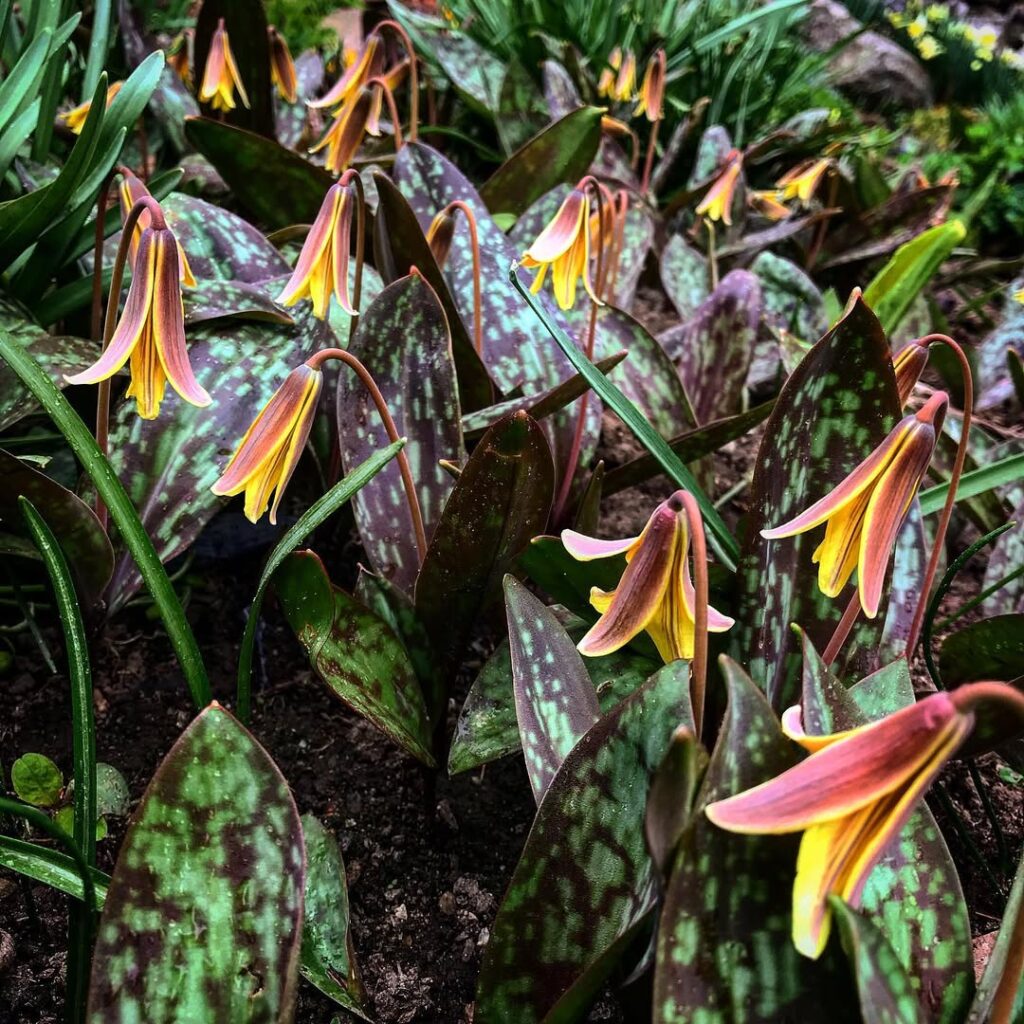
The Trout Lily is a stunning native wildflower that graces North Carolina’s woodlands each spring with bright yellow blooms. This remarkable perennial emerges in early spring before trees leaf out, creating carpets of mottled leaves and cheerful flowers that reach up to 8 inches tall. Named for its speckled foliage that resembles brook trout markings, this ephemeral beauty completely disappears after blooming, spending most of the year dormant underground.
What makes Trout Lily truly extraordinary is its longevity – colonies can persist for 200-300 years in suitable conditions. The plant thrives in moist, deciduous woodlands and makes an excellent choice for woodland gardens, shaded borders, and naturalized areas where it can spread and establish lasting displays of spring color. The flowers provide valuable nectar for pollinators during the early spring season when few other blooms are available.
- Hardiness: Native to North Carolina and eastern states; extremely hardy in woodland conditions
- Light: Part shade; requires ample sun exposure in early spring before tree canopy fills in
- Water: Consistently moist conditions; thrives along pond or stream banks
- Soil: Acidic soils with pH below 6.8; rich, organic matter; well-draining bottomland or slope conditions
- Fertilizer: Benefits from natural leaf litter and organic matter; minimal fertilizer needed
- Pest/Disease Resistance: Excellent natural resistance; few pest or disease issues
- Growth Rate: Moderate; colonies spread slowly but can persist for centuries once established
Wild Bergamot

Wild bergamot (Monarda fistulosa) is a striking native perennial wildflower that brings both beauty and ecological value to North Carolina landscapes. This clump-forming member of the mint family produces eye-catching clusters of lavender, pink, or white flowers that resemble ragged pompoms atop 2-4 foot tall stems. The aromatic gray-green foliage releases a pleasant minty fragrance when brushed against, adding sensory appeal to gardens.
Beyond its ornamental qualities, wild bergamot serves as an exceptional pollinator magnet, attracting butterflies, bees, and hummingbirds throughout its extended blooming period from May through September. The plant also provides crucial habitat for specialized bees including Dufourea monardae, Perdita gerhardi, and Protandrena abdominalis. Three varieties naturally occur in North Carolina, making it perfectly adapted to local growing conditions and an ideal choice for naturalized areas, perennial borders, and meadow plantings.
- Hardiness: USDA zones 3-9
- Light: Full to partial sun
- Water: Moderate; adaptable to various moisture levels from dry to wet conditions
- Soil: Well-drained; adaptable to wide range of soil types
- Fertilizer: Low maintenance; typically does not require supplemental feeding
- Pest/Disease Resistance: Excellent resistance to powdery mildew compared to other Monarda species
- Growth Rate: Moderate; requires division every 2-3 years to maintain vigor
Wild Columbine
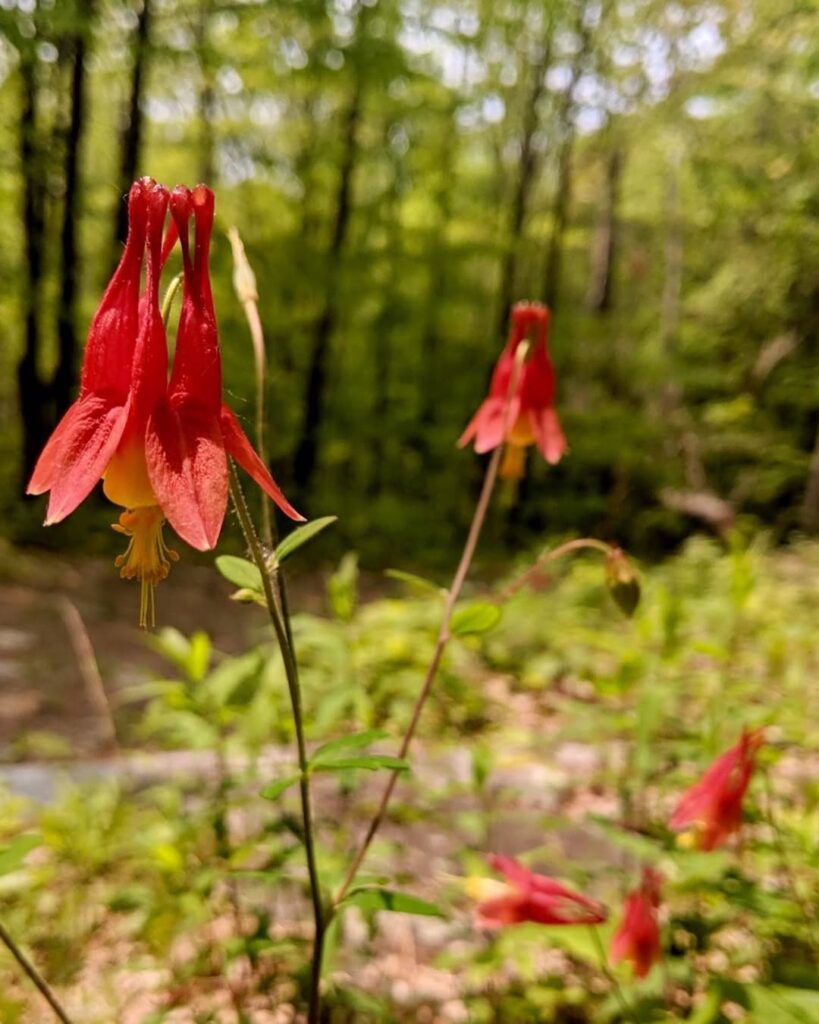
Wild columbine (Aquilegia canadensis) is a stunning native perennial that graces North Carolina’s woodlands with distinctive nodding flowers featuring red sepals, yellow petals, and characteristic hollow red spurs. Growing 1-3 feet tall, this member of the Buttercup family blooms from late spring through summer, typically peaking in May and June. The attractive blue-green compound leaves remain appealing throughout the growing season, with outer leaves turning crimson in fall, making it valuable for both its flowers and foliage. The flowers contain nectar pockets that specifically attract long-tongued pollinators like hummingbirds, moths, and butterflies.
- Hardiness: Native perennial, hardy throughout North Carolina
- Light: Partial shade to full shade
- Water: Moderate water needs, drought tolerant once established
- Soil: Well-draining, calcareous soils; not too rich or fertile
- Fertilizer: Low fertility requirements; avoid over-fertilizing
- Pest/Disease Resistance: Generally pest and disease free
- Growth Rate: Moderate; self-seeds readily in suitable conditions
Majestic Canopy Trees
North Carolina’s native canopy trees create stunning overhead landscapes while supporting wildlife and ecosystems. From mighty oaks to fast-growing sycamores, these giants provide shade, beauty, and ecological benefits. Their deeper roots help capture and filter stormwater runoff, reducing flooding in surrounding areas.
Red Oak
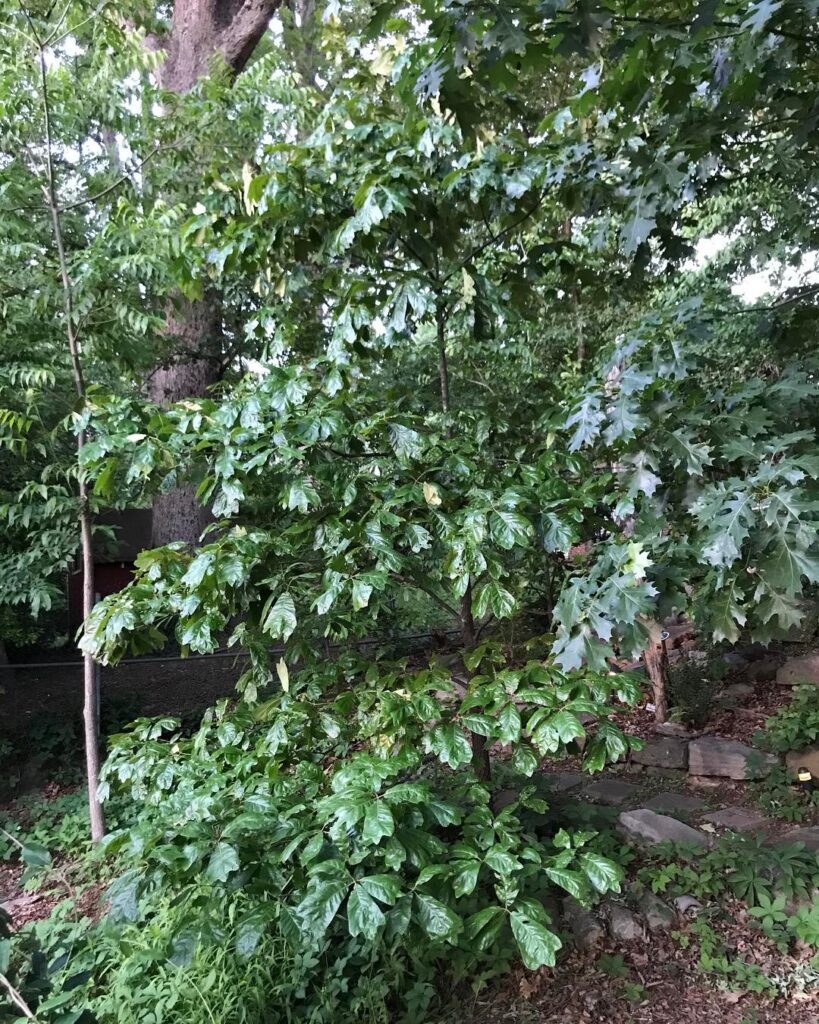
Red Oak stands as one of North Carolina’s most impressive native canopy trees, with mature specimens reaching 60-100 feet in height and spreading 50-60 feet wide. The Southern Red Oak (Quercus falcata) thrives throughout the state up to 2,000 feet elevation, featuring distinctive dark green leaves with tan, hairy undersides and 3-5 bristle-tipped lobes. These majestic trees are prized for their broad, rounded crowns and dark brownish-black bark with deep grooves.
With exceptional longevity of up to 400 years, Red Oaks serve as cornerstone species in both natural forests and urban landscapes. Their high wildlife value supports numerous bird and mammal species through abundant acorn production, while providing critical shade and canopy cover. The productive acorns take a full two growing seasons to mature, ensuring consistent food sources for wildlife across multiple years. The trees’ drought tolerance and adaptability make them excellent choices for parks, streets, and residential settings.
- Hardiness: Hardy throughout North Carolina, tolerates various environmental stresses
- Light: Full sun to partial shade
- Water: Drought tolerant once established, can withstand occasional flooding
- Soil: Adapts to acidic, sandy loam, gravelly, or clay loam soils; prefers well-drained locations
- Fertilizer: Generally not required in native soil conditions
- Pest/Disease Resistance: Good resistance when properly sited
- Growth Rate: Fast-growing, can reach 16-20 feet in 10 years under ideal conditions
Tulip Poplar
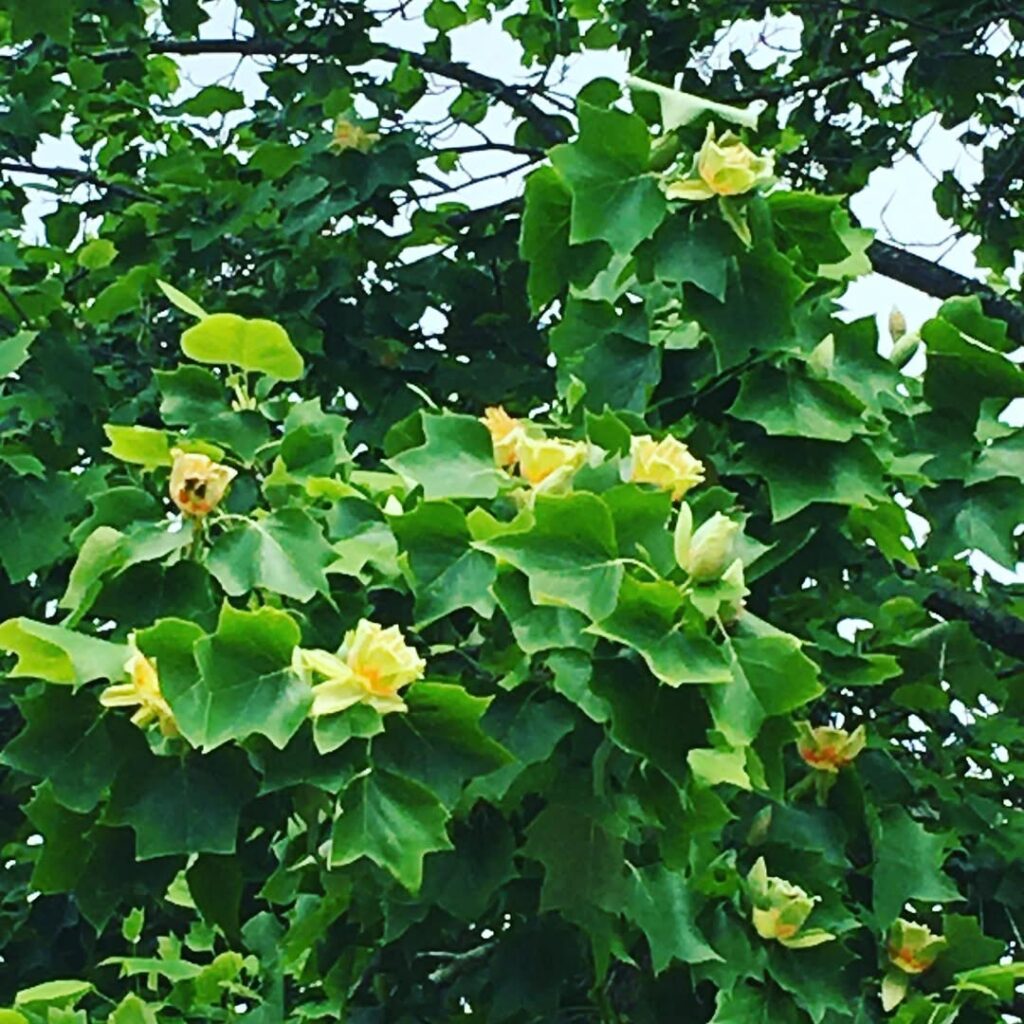
The Tulip Poplar stands as one of North Carolina’s most magnificent native trees, reaching impressive heights of 90-120 feet with exceptional specimens soaring beyond 150 feet. Distinguished by its distinctive four-lobed leaves and striking tulip-shaped flowers that bloom in late spring, this majestic species serves as a cornerstone of the state’s forest canopy.
Beyond its ornamental appeal, the Tulip Poplar provides essential ecological services as a major nectar source for pollinators and host plant for Eastern Tiger Swallowtail butterflies. Its rapid growth rate and abundant annual seed production make it invaluable for natural forest regeneration, while its high-quality lumber has supported both historical uses by Native Americans and modern commercial forestry operations. The distinctive greenish-yellow heartwood makes this species particularly valuable for furniture making and construction applications.
- Hardiness: USDA Zones 6-8
- Light: Full sun to partial shade
- Water: Consistent moisture, prefers moist conditions
- Soil: Deep, rich, well-draining soils; thrives in bottomlands and cove forests
- Fertilizer: Low maintenance; benefits from organic matter in native forest settings
- Pest/Disease Resistance: Generally resistant with few serious issues
- Growth Rate: Rapid, especially in ideal moist, rich soil conditions
American Beech
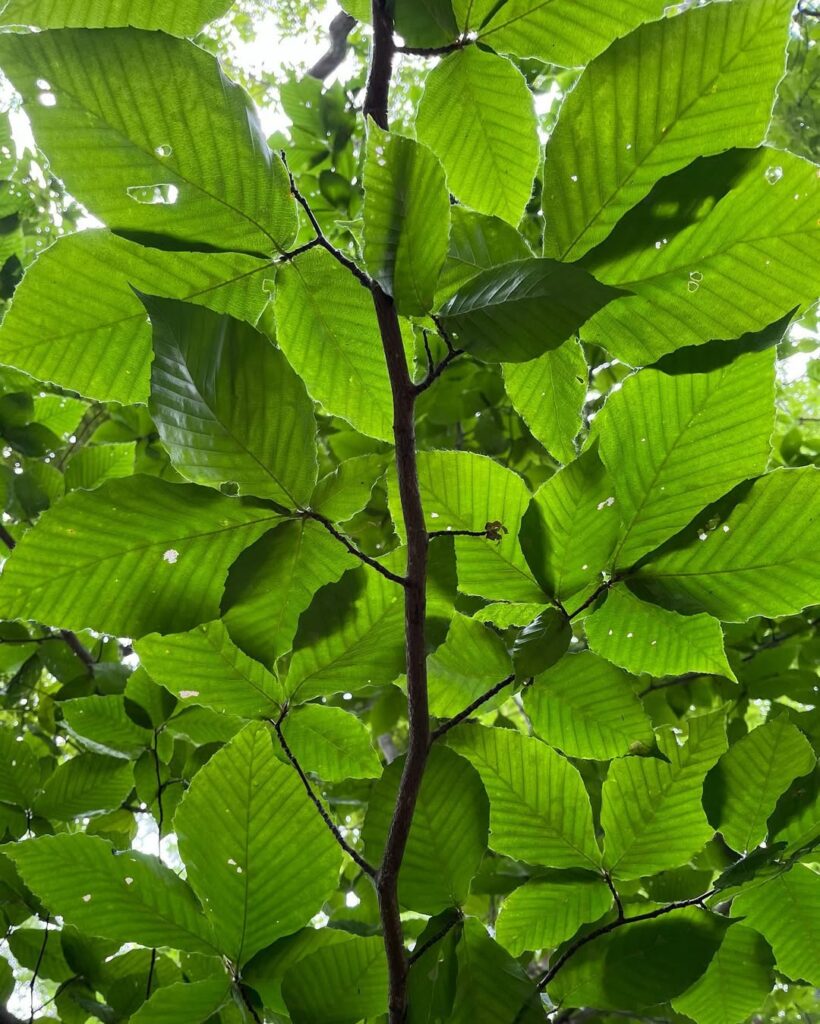
The American Beech is a magnificent native deciduous tree that can reach towering heights of 60-80 feet and live for centuries, with some specimens estimated at over 360 years old. This slow-growing giant is indigenous to eastern North America, including North Carolina, and serves as a cornerstone species in mature forest ecosystems.
As one of the most shade-tolerant trees in its range, American Beech often forms climax communities with sugar maple and plays a vital ecological role in final-stage forest succession. The species is distinguished by its characteristic smooth, silver-gray bark and dark green leaves with small teeth that measure 6-12 cm long. Despite its impressive longevity and ecological significance, this majestic canopy tree requires specific growing conditions and has notable limitations, including intolerance to urban pollution and exceptionally high water requirements.
- Hardiness: Zones 3-9, native to eastern North America from Nova Scotia to northern Florida
- Light: Partial shade to full shade; highly shade-tolerant
- Water: High water requirements; needs twice as much water as other trees in its range
- Soil: Moist, well-drained, rich soils; intolerant of soil compaction and flooding
- Fertilizer: Rich bottomland soils preferred; benefits from organic matter
- Pest/Disease Resistance: Susceptible to beech bark disease; intolerant of urban pollution and salt
- Growth Rate: Very slow-growing; 5.5-inch diameter trunks average 80 years old
Eastern Redbud
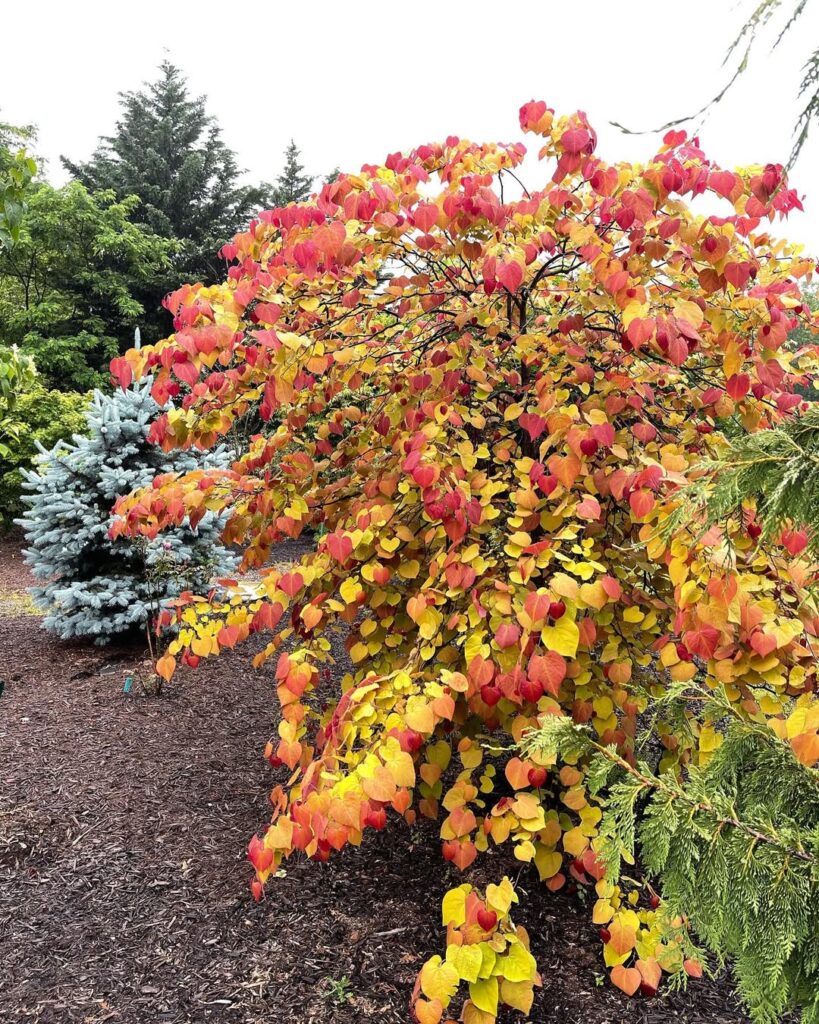
The Eastern Redbud is a stunning deciduous ornamental tree native to North Carolina, reaching 15-30 feet tall with a distinctive umbrella-like crown. This member of the bean family is renowned for its spectacular spring display when glorious pink to reddish-purple flowers emerge directly from the trunk and branches before leaves appear, typically from March to May.
One of the first trees to bloom each spring, the Eastern Redbud features unique heart-shaped leaves with prominent radiating veins and develops flat seed pods after flowering. Its picturesque maroon-purple trunk often divides close to the ground, creating an attractive multi-stemmed appearance that makes it highly valued as a landscape specimen. The tree provides important early spring nectar for butterflies and other pollinators when few other flowering plants are available.
- Hardiness: USDA zones 4-9, native to eastern and south-central United States
- Light: Full sun to partial shade, naturally thrives in forest understory conditions
- Water: Moderate moisture when establishing, becomes drought tolerant once mature
- Soil: Well-drained soils of moderate to low fertility, adaptable to various soil types
- Fertilizer: Low fertility requirements, typically does not need supplemental feeding
- Pest/Disease Resistance: Generally hardy with good resistance to common issues
- Growth Rate: Moderate growth rate, reaching maturity in 10-15 years
Flowering Dogwood
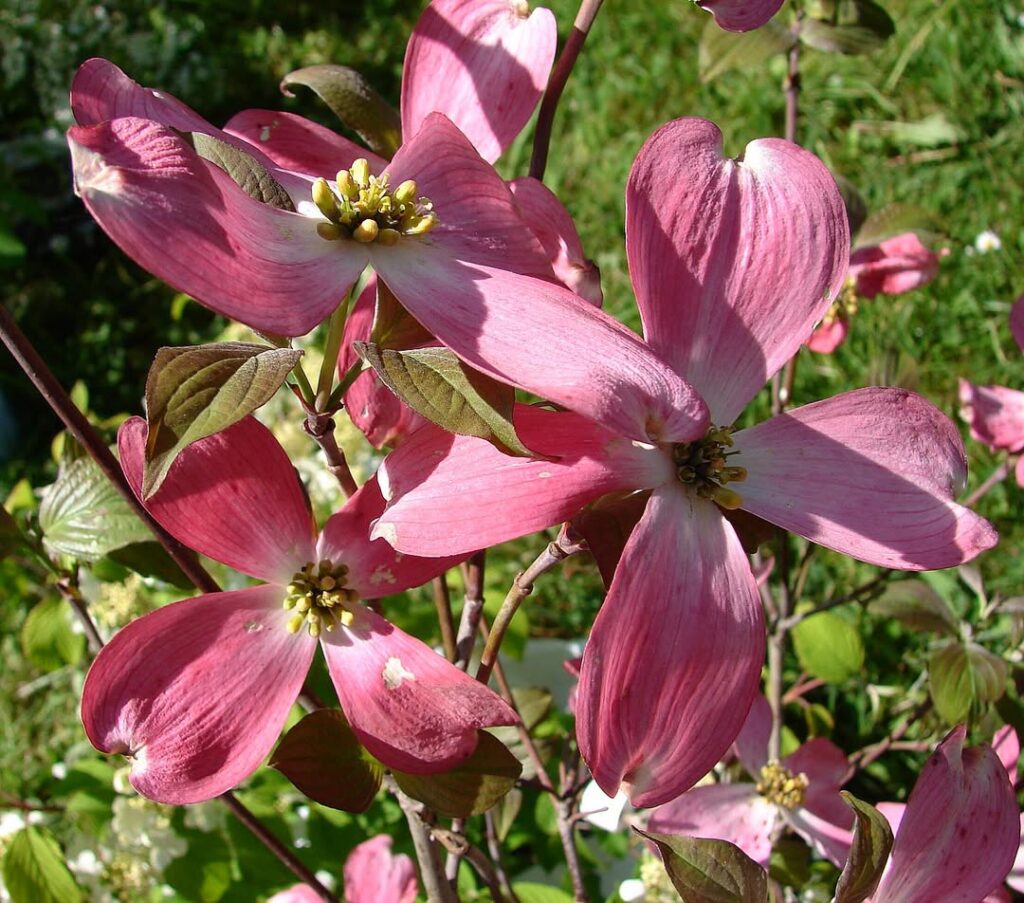
The Flowering Dogwood (Cornus florida) stands as North Carolina’s official state flower and one of the most beloved native trees throughout the eastern United States. This small deciduous tree reaches 15-25 feet in height and creates stunning spring displays with its distinctive white “flowers” – actually four petal-like bracts surrounding clusters of tiny true flowers.
Found naturally from North Carolina’s coast to mountain elevations up to 4,500 feet, this majestic canopy tree thrives in woodland margins and understory environments. Its red fruits provide essential winter food for songbirds and wildlife, while the hard, shock-resistant wood has historically been valued for its exceptional durability. The tree serves as a host plant for the spring Azure butterfly and supports specialized native bees like Andrena fragilis.
- Hardiness: USDA zones 5-9, native throughout North Carolina from coastal to mountain regions up to 4,500 feet elevation
- Light: Full sun to partial shade; requires afternoon shade in Piedmont and coastal regions during hot summers
- Water: Moderate moisture requirements; benefits from consistent watering during establishment and dry periods
- Soil: Well-drained soil with high organic matter content; prefers slightly acidic to neutral pH conditions
- Fertilizer: Low fertilizer needs; benefits more from organic matter and proper mulching than heavy feeding
- Pest/Disease Resistance: Susceptible to anthracnose and dogwood borer; Cornus kousa varieties show better disease resistance
- Growth Rate: Slow to moderate growth rate; takes time to establish but demonstrates good heat tolerance once mature
Essential Native Shrubs for Landscapes
North Carolina’s native shrubs offer exceptional wildlife support, striking seasonal beauty, versatile landscape applications, significant ecological benefits, and straightforward planting requirements for homeowners. These adaptable plants thrive in moist, well-drained acidic soils and sunny locations throughout the state.
Mountain Laurel
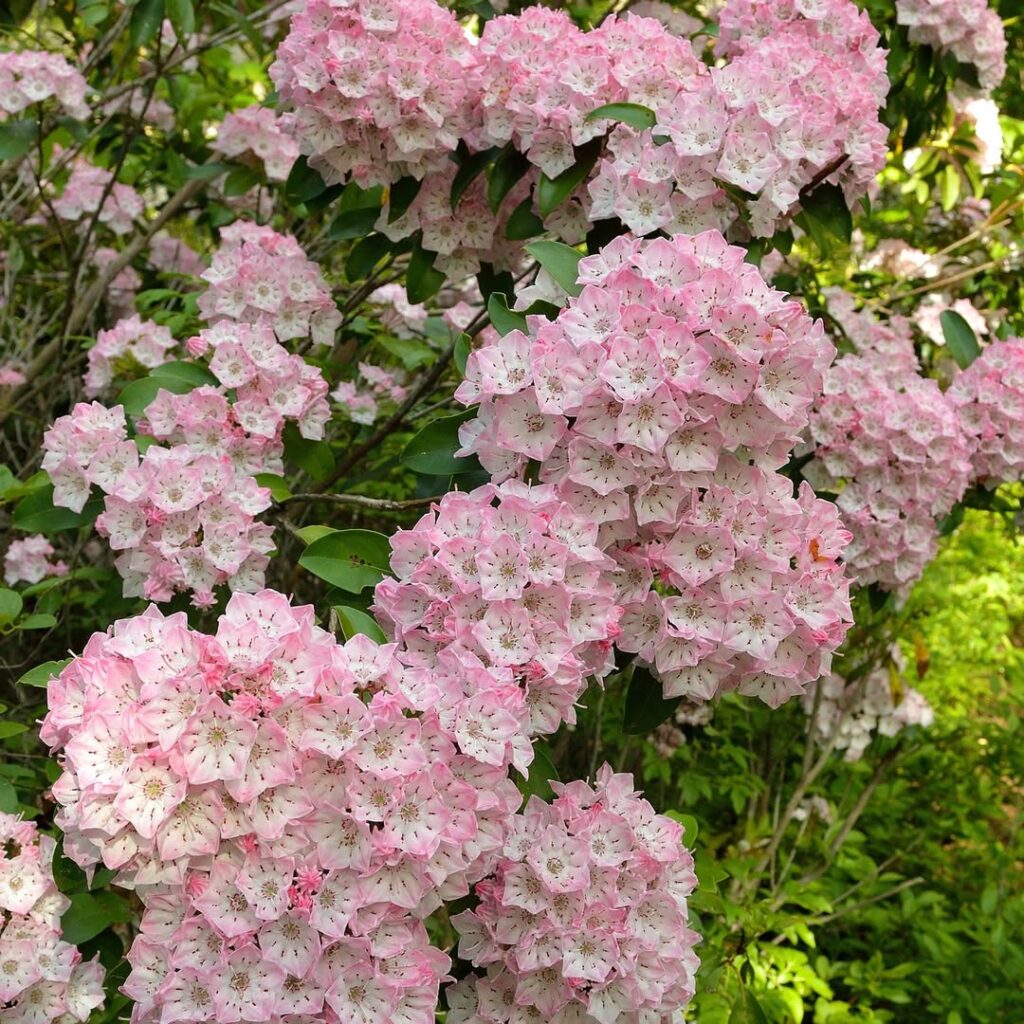
Mountain Laurel stands as one of North Carolina’s most prized native shrubs, offering exceptional ornamental value with its spectacular late spring blooms and year-round evergreen foliage. This adaptable woodland native produces clusters of distinctive white to pink bell-shaped flowers with rose spots, creating stunning displays in naturalized settings. Historically significant for crafting and named by Linnaeus, Mountain Laurel provides excellent deer resistance and serves as an important pollinator plant while maintaining a compact, rounded form perfect for landscape applications. The species also serves as a larval host for the Laurel sphinx butterfly, supporting native pollinator populations.
- Hardiness: Zones 4-9, highly adaptable to various elevations in Appalachian regions
- Light: Full sun to part shade, flourishes best in dappled woodland light
- Water: Moderate moisture requirements, drought tolerant once established
- Soil: Acidic, well-drained soils; thrives on rocky slopes and forest understories
- Fertilizer: Low maintenance, minimal fertilization needed in native settings
- Pest/Disease Resistance: Excellent deer resistance due to toxic compounds, generally pest-free
- Growth Rate: Slow to moderate, reaching 4-10 feet tall, occasionally up to 20 feet
Spicebush

Spicebush (Lindera benzoin) is a versatile native shrub that serves as a cornerstone species in North Carolina’s woodland ecosystems. This aromatic deciduous plant produces fragrant yellow flowers in early spring before its leaves emerge, followed by glossy red berries that provide vital nutrition for migrating songbirds. The plant’s spicy-scented foliage turns brilliant golden yellow in fall, adding seasonal interest to naturalized landscapes.
Beyond its ornamental value, spicebush functions as an essential wildlife habitat plant, serving as the primary larval host for Spicebush Swallowtail butterflies while providing nesting sites for Wood Thrushes and other forest birds. The drupes have a distinctive peppery taste that makes them valuable for both wildlife consumption and potential culinary uses. Its adaptability to various light conditions and soil types makes it an excellent choice for woodland gardens, naturalized borders, and bird-friendly landscapes throughout USDA zones 4-9.
- Hardiness: USDA zones 4-9
- Light: Partial shade preferred; tolerates full sun
- Water: Moist to medium-moist conditions; requires adequate moisture
- Soil: Adaptable to sandy loam through clay; prefers well-draining soils
- Fertilizer: Low requirements; benefits from organic matter and mulching
- Pest/Disease Resistance: Generally resistant with few serious issues
- Growth Rate: Moderate; reaches 6-15 feet at maturity
Elderberry
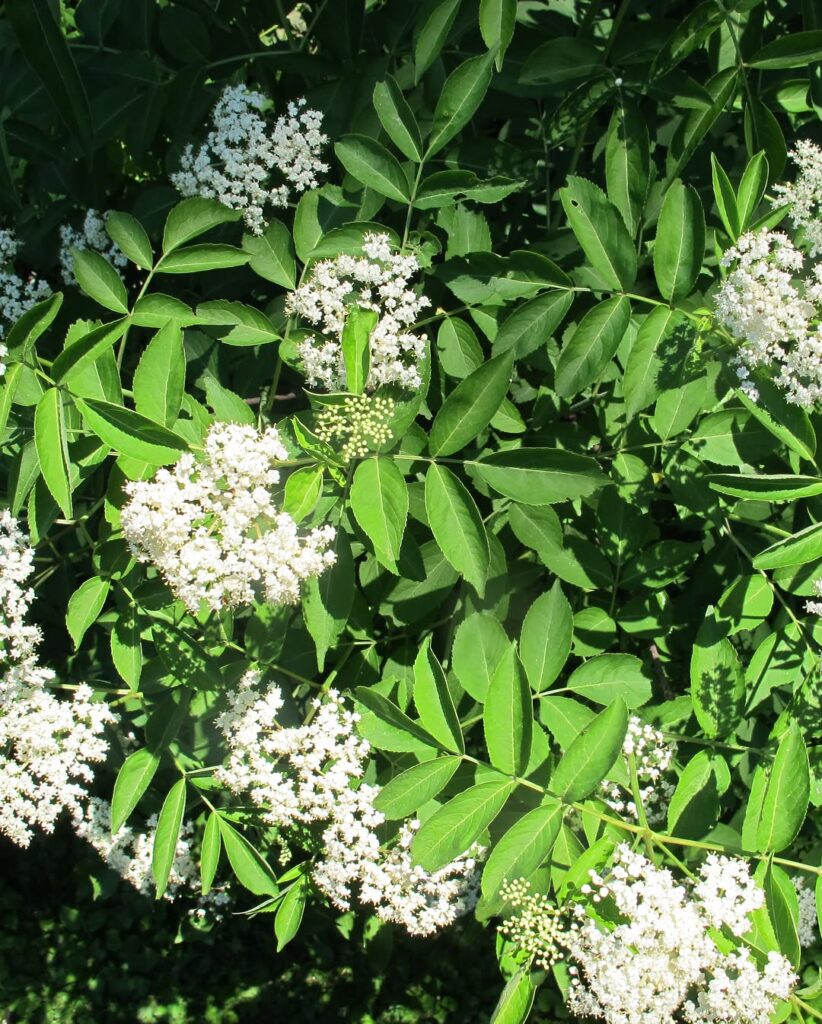
Elderberry is a versatile native shrub that serves as an excellent foundation plant for North Carolina landscapes. This multi-stemmed deciduous shrub reaches 5-12 feet in height and produces striking clusters of white flowers in late spring, followed by dark purple berries that provide valuable wildlife food. Its rapid growth and adaptability make it ideal for naturalized areas, woodland edges, and privacy screens.
Beyond its ornamental value, elderberry offers significant ecological benefits by attracting pollinators and supporting numerous bird species. The berries are also edible for humans and can be processed into jellies, syrups, and wines. The shrub features pinnately compound leaves with 5 to 11 leaflets that provide attractive foliage throughout the growing season. This hardy native thrives throughout all regions of North Carolina and provides year-round landscape interest.
- Hardiness: USDA zones 5a-7b
- Light: Full sun to partial shade (2-6 hours direct sunlight)
- Water: Moist, well-drained conditions; tolerates various moisture levels
- Soil: Adaptable to clay, sand, loam, and high organic matter soils
- Fertilizer: Low requirements; benefits from organic matter
- Pest/Disease Resistance: Generally good resistance to common issues
- Growth Rate: Rapid growth for quick establishment
Beautyberry
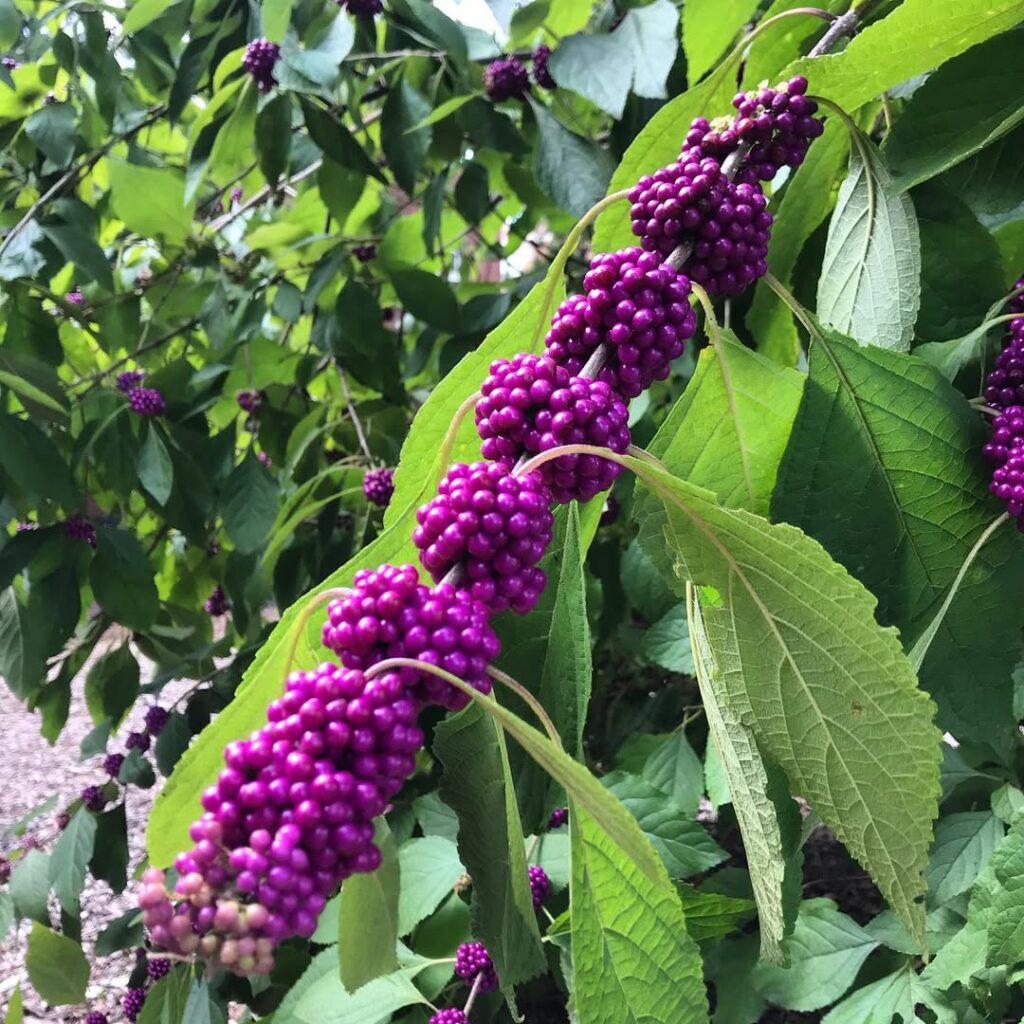
Beautyberry is a spectacular native shrub that transforms North Carolina landscapes with its vibrant magenta to metallic purple berry clusters in late summer and fall. Growing 5-8 feet tall and wide, this adaptable plant thrives in various conditions while providing exceptional wildlife value, attracting birds, pollinators, and small mammals.
Beyond its ornamental appeal, beautyberry serves multiple landscape functions from specimen plantings to natural screens. The striking berry display persists through winter, offering ongoing seasonal interest and wildlife food when other sources are scarce. Its low-maintenance nature and quick establishment make it an excellent choice for both formal gardens and naturalized areas. The plant may experience winter die-back in colder areas but reliably reemerges each spring.
- Hardiness: USDA zones 7-10
- Light: Full sun to part shade (more sun produces better berry display)
- Water: Moderate; drought-tolerant once established, prefers moist conditions
- Soil: Adaptable to various soil types; prefers well-drained sites
- Fertilizer: Low requirements; thrives without supplemental feeding
- Pest/Disease Resistance: Generally pest-free; susceptible to leaf spots and stem diseases
- Growth Rate: Quick to establish with moderate to fast growth rate
Rhododendron
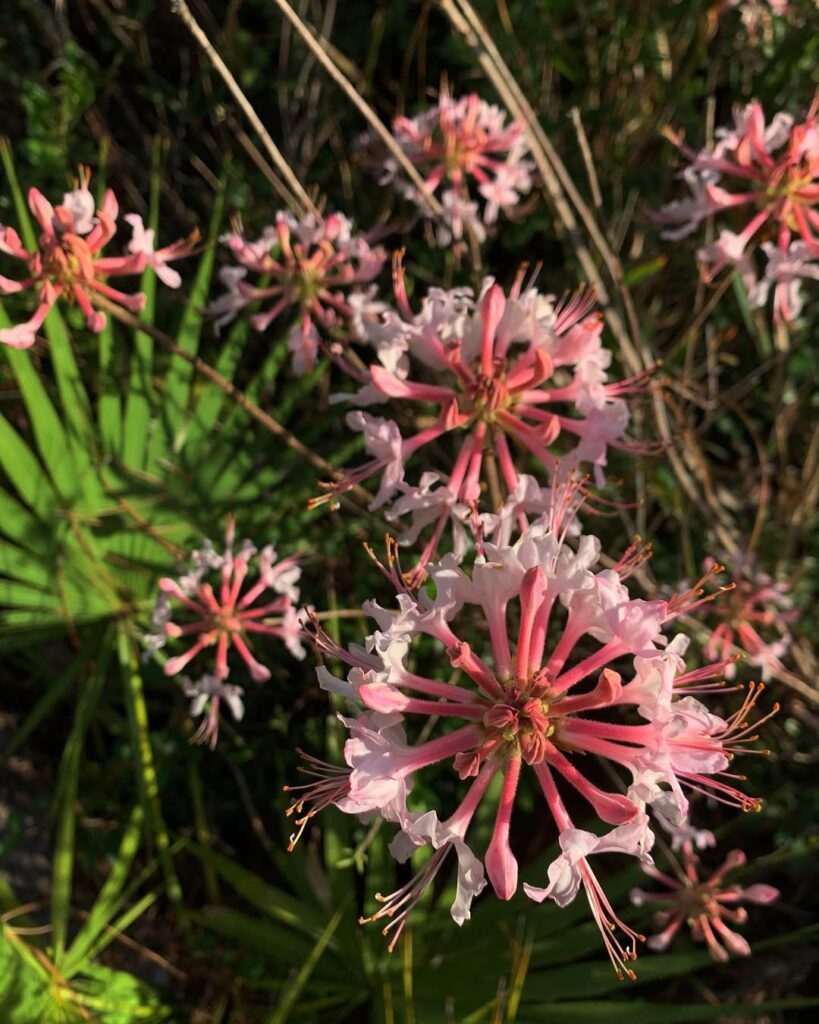
Rhododendrons are essential native shrubs that form the backbone of North Carolina’s woodland landscapes. The Catawba and Rosebay species are particularly abundant throughout the state’s Appalachian regions, offering spectacular spring blooms in shades of purple, pink, and white. These broadleaf evergreen shrubs provide year-round structure and visual interest to gardens.
Beyond their ornamental value, native rhododendrons serve critical ecological functions by supporting pollinators like hummingbirds and specialized bees while providing wildlife shelter. Their extensive root systems make them excellent choices for slope stabilization and erosion control. Once established, these adaptable shrubs require minimal maintenance while delivering maximum landscape impact in woodland gardens and naturalized areas. The genus name rhododendron comes from Greek words meaning rose and tree, reflecting the plant’s beautiful flowering nature.
- Hardiness: USDA zones 4-8, well-adapted to North Carolina’s climate
- Light: Partial shade preferred; avoid full sun which can scorch foliage
- Water: Consistent moisture required, especially during establishment; avoid waterlogged conditions
- Soil: Acidic, well-drained soil with high organic matter content
- Fertilizer: Low requirements; benefits from organic mulch and compost
- Pest/Disease Resistance: Good resistance compared to non-native ornamental shrubs
- Growth Rate: Moderate; reaches 5-20 feet at maturity depending on species
Selecting the Right Native Plants for Your Garden
How do you choose the perfect native plants when North Carolina’s landscape stretches from mountain peaks to coastal shores? Consider plant hardiness and soil types for your specific region first. Coastal Plain plants thrive in sandy soils and warmer temperatures, while mountain varieties prefer different conditions.
Use NC State Extension’s Plant Toolbox, featuring over 1000 native profiles, to narrow your selection. The Audubon list includes 692 bird-friendly options across all regions.
- Watch butterflies dance through your garden as native plants host 30+ moth species
- Hear songbirds feast on seeds you’ve provided through thoughtful plant selection
- Feel the satisfaction of supporting North Carolina’s rich botanical heritage
- Create habitat that wildlife desperately needs to survive
For additional guidance, contact Dr. Lucy Bradley, Extension Specialist in Consumer & Community Horticulture, who can provide expert consultation on native plant selection. Match flowering times and heights to your garden’s design goals.
Frequently Asked Questions
How Long Does It Take for Native Plants to Establish in North Carolina?
Like roots weaving underground tapestries, your native plants need 2-3 years to fully establish in North Carolina. Proper planting techniques accelerate this establishment timeline, with perennials showing strength by year two, trees requiring 3-5 years.
What Native Plants Are Deer Resistant in North Carolina Gardens?
You’ll find excellent deer deterrent plants among North Carolina natives including Carolina cherry laurel, Eastern redbud, and Christmas fern. These landscaping tips help create beautiful, resistant gardens using bugbane, salvias, and native jasmine varieties.
When Is the Best Time to Plant Native Species in North Carolina?
You’ll find fall planting from October through December offers the best results for native species. Spring planting works too, but fall’s cooler temperatures and moist soil help plants establish stronger root systems before winter.
Do North Carolina Native Plants Require Special Fertilizers or Soil Amendments?
Why complicate what nature’s already perfected? North Carolina’s native plants don’t need special fertilizers since they’re adapted to local soil pH and nutrient requirements. You’ll save money while supporting plants that naturally thrive here.
Where Can I Purchase Native Plant Seeds and Seedlings in North Carolina?
You can purchase native plant seeds and seedlings from specialized seed nurseries like Carolina Native Nursery or Sow True Seed, plus local farmers markets where vendors like Carolina Heritage and Wildbud Natives sell regularly.
